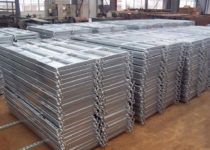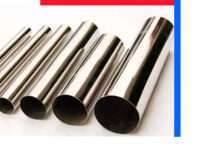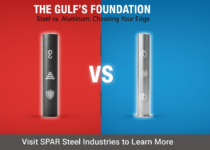Navigating the Scaffolding Equipment Market (2025-2033): Build Smarter, Not harder.

The Scaffolding Components Landscape: An Introduction
The scaffolding industry is at the heart of modern infrastructure, oil & gas, and industrial development. Whether it’s the construction of mega skyscrapers in Dubai, refinery expansion projects in Saudi Arabia, or power and water plants across the GCC, scaffolding is the silent backbone that ensures safety, access, and productivity. From 2026 to 2033, the global scaffolding equipment market is projected to grow steadily from USD 55 billion (2024) to USD 78 billion (2033), at a CAGR of 4.5%. For manufacturers like SPAR Steel Industries, headquartered in the UAE and with operations across Saudi Arabia –Arabian SPAR, this growth is both a challenge and an opportunity, especially in the Scaffolding Equipment Market.
In this blog, we explore market trends, technological innovations, sustainability shifts, regional opportunities, and SPAR Steel’s leadership in scaffolding solutions.
Market Drivers & Growth Dynamics
Significantly, infrastructure megaprojects across the Asia-Pacific and the Middle East are actively fueling demand for advanced scaffolding solutions. Moreover, stringent safety regulations, such as OSHA 1926, BS 1139, EN 12810, Aramco GI 8.001, and ADNOC standards, are simultaneously ensuring a foundation of compliance-driven growth in the sector. In parallel, technological innovations are reshaping operations, specifically with the introduction of IoT-enabled smart scaffolding, Building Information Modeling (BIM) integration, and the use of AI for predictive maintenance. Finally, the overarching theme of sustainability is fundamentally altering scaffolding material usage, which is being achieved through the adoption of lightweight steel, eco-friendly coatings, and fully recyclable boards.
Scaffolding Equipment Market Challenges
- Complex regulatory frameworks across different regions increase compliance costs.
- Steel price volatility continues to impact profitability for manufacturers and suppliers.
- Supply chain disruptions highlight the need for local manufacturing hubs.
- Intense competition from Asian manufacturers drives price pressure.
Market Segmentation Insights
Initially, the market is categorized by Type, which encompasses traditional options like single & double configurations and trestle forms, along with specialized and modern systems such as cantilever, suspended, and modular steel. Furthermore, the segmentation extends to the Application Level, where scaffolding solutions span essential sectors. These include large-scale construction projects and critical industrial needs, specifically oil & gas/petrochemical maintenance and general industrial upkeep, in addition to highly specialized uses like interior decoration and event setups.
Finally, a breakdown by Region reveals significant global dynamics: North America is characterized as a mature market; conversely, Europe is predominantly driven by sustainability requirements; Asia-Pacific consequently commands the largest market share due to rapid infrastructure growth; the Middle East remains heavy with oil & gas projects; and lastly, Latin America is strategically positioned as an emerging region.
Scaffolding Equipment Regulatory & Safety Framework
OSHA 1926.451–454 governs the use and safety of scaffolds in the U.S.
BS 1139, BS 5973, and BS 2482 standards set benchmarks in the UK and GCC approvals.
EN 74, EN 12810, and EN 12811 define European requirements.
Saudi Aramco GI 8.001, ADNOC HSE, and SABIC guidelines drive compliance in the Middle East.
ADWEA Guidelines (2009) outline specifications for tube fittings, scaffold boards, and inspections.
Growth Path and Expansion Potential of Scaffolding Equipment (2026–2033)
- Digital transformation through BIM and AI predictive monitoring.
- Robotics and automation in scaffold erection and dismantling.
- Fire-retardant alloys and hybrid steel-composite planks.
- Sustainability focus with recyclable steel and low-toxicity coatings.
- Growth in Asia-Pacific, the Middle East, and emerging African markets.
Benchmarking Table
| Company | Region | Core Strength | Key Clients | Differentiator |
| Layher | Europe/Global | System scaffolding innovation | Construction majors | Speed & modular design |
| PERI | Europe/Global | Formwork + scaffolding | Industrial projects | Integration & design support |
| Altrad | Europe/Global | Industrial services | Oil & Gas | M&A growth, service model |
| SPAR | UAE/KSA | Cuplok, Ringlock, Steel Boards | Aramco, ADNOC, SABIC | Local compliance & regional leadership |
| KHK Scaffolding | UAE | Export strength | Contractors in GCC | Cost-effective supply |
Conclusion
Ultimately, the strategic trajectory of the scaffolding equipment market between 2026 and 2033 will be shaped by innovation, compliance, and infrastructure spending. Consequently, companies like SPAR, Layher, Altrad, and PERI are indeed positioned to lead with modular systems, eco-friendly products, and digital integration. However, balancing cost efficiency with premium safety and sustainability will, in the final analysis, define success in this competitive market.



